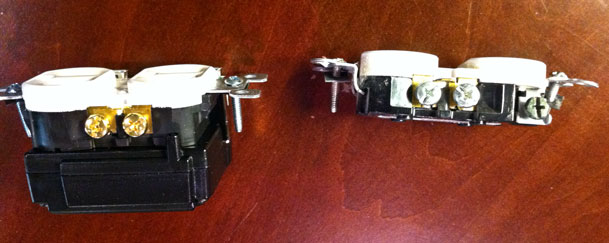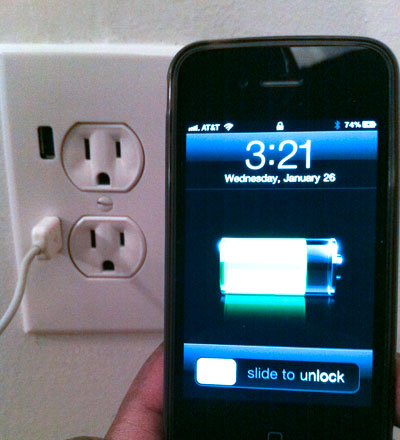
I remember about a year ago when FastMac teased us with this product. I'm sure they wanted to release it sooner, but they went back to the drawing board and redesigned a better product! The U-Socket is designed to replace your standard US 110V outlet with one that also has two powered USB ports. This way you can charge two standard USB devices and still have access to both outlets for other devices. I ordered three of these and while I didn't expect them until February, they surprisingly showed up yesterday. I was like a kid on Christmas day. I don't know why I was so excited to see such a simple product, but I just think these things are cool.
Before you do it yourself

Electricity doesn't really frighten me. Plumbing and Natural Gas on the other hand do. Although this device has standard electrical wiring like most outlets, it is an electrical installation and if you are the least bit squimish please please please hire a licensed Electrician to install yours. I'm not responsible if you, your devices or your house get fried! I warned you! I'm warning you again. Let a professional do it! With that said, I've been installing replacement outlets and light switches in my house for years. So I was not afraid to TURN OFF the circuit at the circuit breaker and then proceed with the installation. Although the wiring is very straight forward it took a little longer than usual. The biggest problem is that outlet is about twice the depth of a standard outlet. Yes it's designed to fit in a standard box, but it will be tight. The one that I replaced had a little plaster around the box that I had to take my time and chip away first. I also had to be more careful about how I ran the wires around the outlet itself as there is very little wiggle room. To this point I went to install the other two in a newer part of my home and the wiring was more complicated. While I could certainly do it, I would rather pay the electrician to do it as I don't feel like playing trial and error with the connections that are already in those boxes.
Success

Once I got it installed and restored power to the outlet I couldn't wait to test it. First I tested the regular AC plugs and they worked. Then I plugged in a USB cable and my iPhone 4 and heard the familiar tone the indicated that it was charging.
What about the iPad? As you may or may not know the iPad wants 10v of USB power instead of the standard 5v required by most USB products. I expected to get the "not enough power" message when I plugged in the iPad, but to my surprise it gave me the same tone that it was charging. This is actually no different than using an older iPhone charger with your iPad. While it works, it will definitely take LONGER to charge it than the 10v power adapter that comes with the iPad So if I had to give it any strikes that would be the only one. I wish that the ports were 10v instead of 5v. Other than that I think these are really cool.
Correction: The iPad wants 10w, not 10v. FastMac notes iPad "compatibility" . So we're good here!
OLDER USB 2.0 ports only supplied 0.5 amp which would only charge an iPad while it's off or very very slowly while it's on.
Newer USB ports can supply the 1.5 amps that the iPad wants. The U-Socket has enough power at:
- 2.4A-5V USB 3.0 Power Ports @ 2400 mA (total)
- Charge 4 Devices Simultaneously
You can get the U-Socket here for about $24.


Thanks for this review… But just a bit of precision: iPad requires 10 watts of power supply, provided by an USB socket delivering a standard 5 volts but at a higher current level of up to 2 amps !! Thus, requiring a more capable power supply in terms of power ( Power = Volts x Amps ) so many USB sockets will not deliver current above 500 mA or 1 A not enough to charge battery and run the iPad in the same time !!
Got it. Thanks!
@Guy
The reason that most USB ports supply way less than 1 amp is because of the USB spec itself. The spec requires 500 milliamps of current to be delivered (after a ramp-in period IIRC).
I know this because lack of current on a USB 2.0 port is a serious problem for digital DJ’s. Check out my article on the problem at DJ Tech Tools. Many of the MIDI-over-USB DJ controllers require too much current at startup and that causes your USB port to “trip out” (like a house circuit breaker does).
There are vendors that make USB hubs that will give you more than 500 milliamps but they are few and far between.
This is pretty awesome Terry!!
How many times I used my PS2 and Wii usb ports to charge my phone, or my PSP, or whatever!!
I wonder why took them so long to come out with this, is a very “simple” product after all…
Pedro
Pedro says:
“I wonder why took them so long to come out with this, is a very “simple” product after all…”
Pedro, I grew up in the software business. Wrote FORTRAN when that language was Cool.
Making something as “simple” (from the user’s perspective) as an iPad is simply not that simple. Just from the work I’ve done (which in no way comes close to what goes on building a software edifice like iOS) I know how many bullets you have to sweat to “get it right”. That process, to do it as well as what you see as iOS does it, takes incredible amounts of time and quite a few people.
Doing that process right is usually what Microsoft gets completely wrong. That is one reason why people perceive that Macs/iPhones/iPads “just work”.
Erh… I think you got me wrong, I was talking about the U-Socket, and not the iPad… Put a UsB port in a power socket is not that hard…
Fortran “Cool”? Perhaps 77 was tolerable at best.
uhh, close but not quite correct Terry….
iPads want a TEN WATT power connection not a TEN VOLT connection. Hooking your iPad up to a 10 volt power supply could damage the iPad.
USB 2.0 ports are a 5 Volt power source where power is supplied. The same is true for your iPad charger; it supplies 5 volts. Where the “10” comes in is when you multiply volts X amps to get the power capacity (expressed as watts) of the connection. The iPad charger supplies 5 volts at 2 amps which gives us 10 watts of power.
The reason why your iPad will charge slowly, if at all, plugged into the typical USB 2.0 port on your computer is that USB 2.0 ports that supply power are only required to supply 500 milliamps at 5 volts which supplies 2.5 watts total. That is only a quarter of the power supplied by the iPad charger.
hope that clarifies things a bit.
dennis
Sorry, a typo on my part. Thanks!
Hi, I just received mine in the mail yesterday and cant wait to try it. Plan on doing the install this weekend. I hope they come out with a GFIC one in the future so the outlets blend in with the rest of my kitchen sockets.
P.S. My main reason is I have two IPhones with one socket for charging and the other running the coffee pot.
Thx, Glenn N
@Glenn –
Don’t go to sell your house with this installed in your kitchen (or bathroom)! Most building codes now require GFI outlets in those locations. Having the city inspector stop your sale can become costly – pulling a permit, paying a fine (possibly), hiring a contractor (likely), paying for a re-inspection. And that does not even account for the lost time…
Just a little extra info for everybody…
Good thing I have an electrician in the family and do not plan on selling my house till Im dead.
Also, thats why I want a GFI version.
LOL. Glenn N
If installing this in a kitchen circuit, you only need one GFI on a circuit. This is fine if it is a second outlet on the circuit with a GFI.
You only need one GFI on a circuit. This is fine if it is a second outlet on the same circuit with a GFI.
This falls under the “wish I had thought of this” category!
I received mine already and also installed it… after waiting nearly a year! It works great for most of my devices, but for some reason will not charge my wife’s older iPhone 3G.
I have used it to charge both my 3GS and my iPad, and it works perfectly. Pretty slick little invention.
Installation was straightforward as noted, but it was very tight in the box. It fit. I’ve replaced several outlets in my home and this took longer than most — not because it’s technically any harder to install, but the larger transformer/box makes it just a little awkward.
While this is definitely a good idea, it’s a terrible implementation…the USB ports are positioned in such a way that any kind of wall wart is going to render them inaccessible. It would have been much better to place them at the top and bottom of the outlet.
No matter where the USB ports are placed there is always the possibility that something you plug in will cover them. For example had they been at the top and bottom as you suggested just about all of my battery chargers and any power brick would be sure to block the bottom one for sure. There is no perfect in this case.
Maybe the “Belkin Mini Surge Protector Dual USB Charger” at Amazon is more appropriate. It is 3 plug-in 3 socket device that also has USB plugs on the side. I would think the mini surge is also preferable. I’m sure others make similar devices, and they can travel with you. Plus its cheaper than a call to the electrician.
Thanks for the interesting review… I have an order in for several of these, can’t wait!
Positioning the ports elsewhere/GFI will be difficult with their approach: rather than start at square one and design/certify the 110VAC part, the transformer is piggybacked on a stock receptacle part, likely drawing power from the screwless ‘strip and poke’ terminals many AC receptacles have on the back. As such, the cover is also standard issue with two extra holes (why no silkscreened USB logos, at least?).
The downside of this ‘discrete’ (albeit justified) packaging approach is bulk; there’s no way to use any ‘wasted space’ that may have existed in the original outlet part. A GFI receptacle is a much larger part, making this approach difficult.
Wow this is a very interesting. So you will just directly charge iPad in the socket? I don’t understand much the technicality but if this works I believe USB sockets rocks. I think this is something we are wishing for.
Yes! You can directly charge the iPad in the socket without the need for the iPad USB charger. All you need is your cable.
My Blackberry & honeypie’s Moto (one’s charger outputs 0.85A and the other 0.75A) connected to this 2.0A output do *not* fully charge over a weekend.
Tech support has not yet responded.
Be careful – it won’t fit in some boxes. And even the ones where it does fit, it will be tight. Electrical code is set up so that box size required is based on the number of wires & connectors in the box. It isn’t really designed for extra stuff like this.